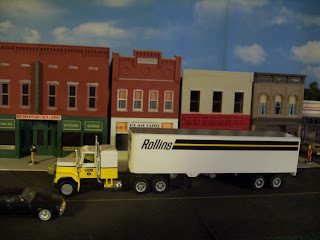The 80's brought about the increase of intermodal traffic through southern Pennsylvania, as the new AP&W had the best transcontinental route between Chicago and the East Coast ports of New York, Baltimore, and Trenton, N.J...
The AP&W also had the best route from Kansas City. Train KCT-35 (Kansas City - Trenton) rolls TOFC (Trailer On Flat Car) traffic east to Trenton behind an ex- Frisco SD40-2 and an EMD SD60 Demo unit.
Among the trailers are a number of UPS 40' drop bottoms. Note also the XTRA Lease 45' and the JB Hunt 48' trailers.
A Availco Preferred Pool and a Vermont Railroad 45-footers share space on a flatcar.
45' trailers from Missouri Pacific and Florida East Coast. This 1986 train is four years after the MoPac was acquired by the Union Pacific. The next flatcar has a 48' Schneider National trailer sharing space with another UPS 40' drop bottom. The combined 88' length of the trailers fits on the 89' flatcar with about a foot between the trailers!
More 48' Schneider National trailers, including a rare white one (a second-hand unit?). Note that these trailers are on a spine car with 48' platforms. The 80's saw the introduction of spine cars to handle longer trailers and containers, as the AAR (American Association of Railroads) set a 89' length limit on single-unit cars. As seen in the previous photo, only one 48' trailer or container can fit on an 89' flatcar, so articulated spine cars were -and still are- the solution to longer trailers and containers. Plus, with only enough deck space for the trailer wheels, the spine cars save a lot of weight versus conventional flatcars.
A Transamerica 45' trailer shares a flatcar with a UPS 40' trailer. Next is a 48' JB Hunt trailer on a Front Runner -a single-unit spine car which featured single-axle trucks at each end.
A string of UPS' ubiquitous 40' drop bottoms, riding on a ten-unit Impack spine car. The AP&W was one of the railroads which dabbled in spine cars during the 80's. and the Impack car was purchased in both 5-unit (50) and 10-unit (10) configurations, with 45' capable units. With the A unit's reversed orientation on the end of the car, this allowed it to carry a 48' trailer, as seen at the end of the train with a 48' Schneider trailer. While the 10-unit cars did well, when one went out of service for maintenance, that was ten less trailers to haul! Plus they were hard to fit inside of the shops, due to their nearly 500' length! The Impacks lasted through the 90's, but were all retired by 2000; with 48' and 53' trailers, only every other unit could be used, plus they weren't equipped to handle containers.

As-yet un-renumbered Frisco 955 shows off the Mandarin Orange and white paint scheme, as well as the roof-top rotating beacon and nose-mounted gyralight; all designed to improve the visibility of the unit -especially at grade crossings. When paint schemes for the new company were being drawn up, one featured this pattern, but with brown substituted for the orange. The 90's "Desert Storm" paint scheme actually used a similar pattern, but with brown and tan instead of orange and white, with white ends.
EMD1 is one of the four SD60 demonstrators built in 1984 to promote EMD's newest creation. The quartet worked all across the seven railroads that would become the AP&W, but with merger details to be worked out, it would be two years before any would be ordered. The first 25 SD60s for the new. company would arrive in the fall of 1986, just months after the merger was finalized.

















































